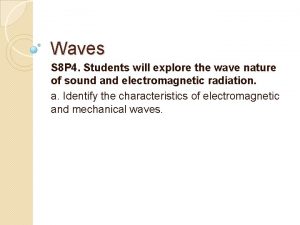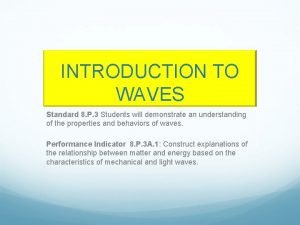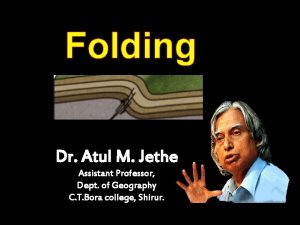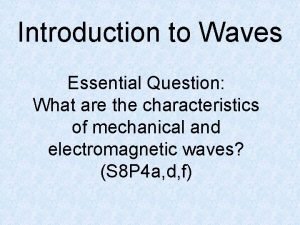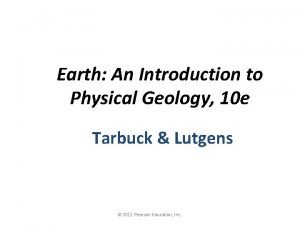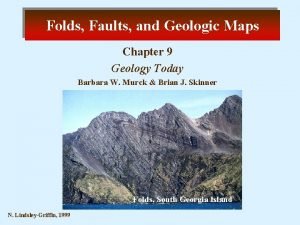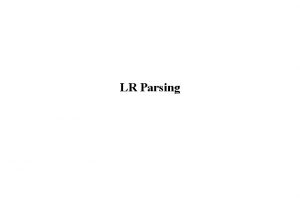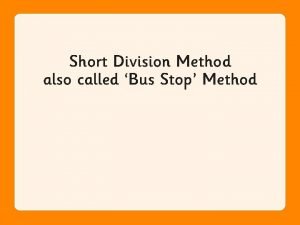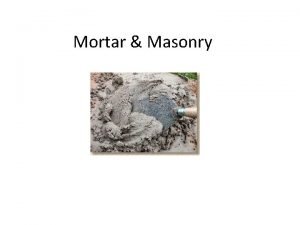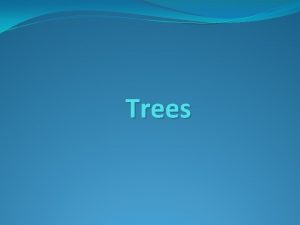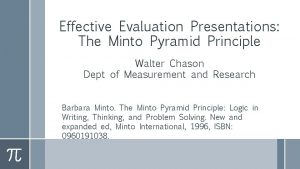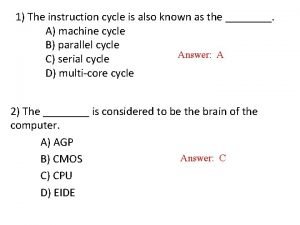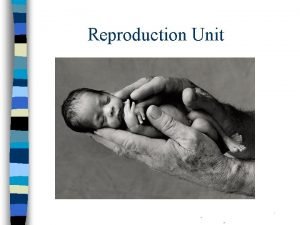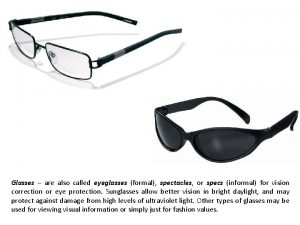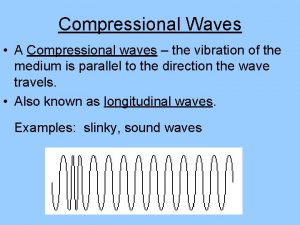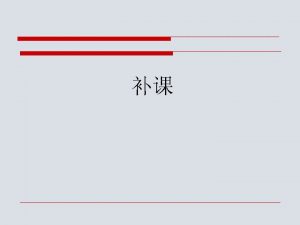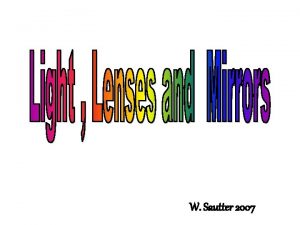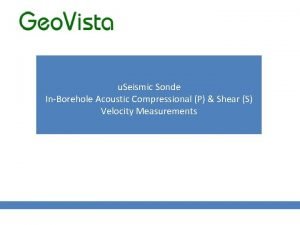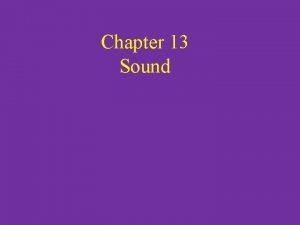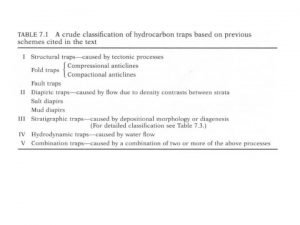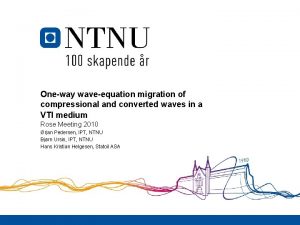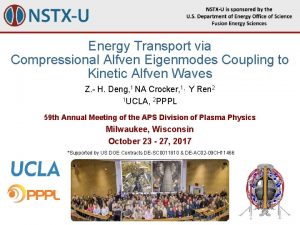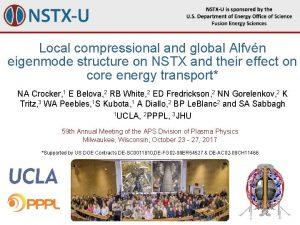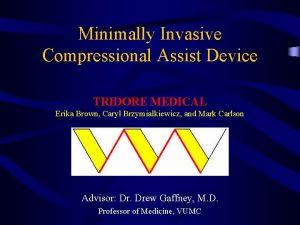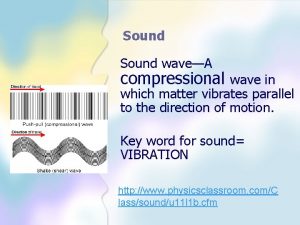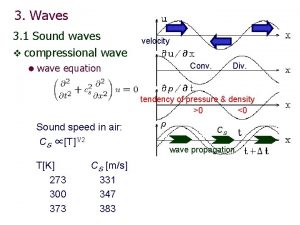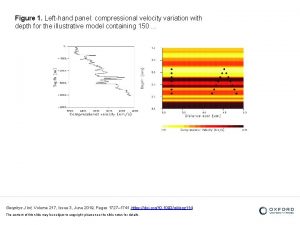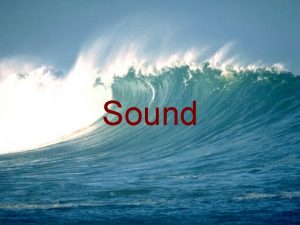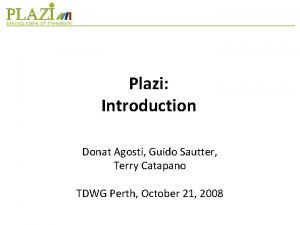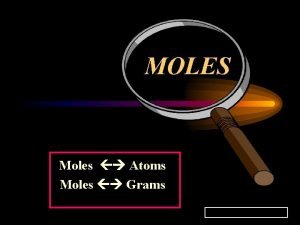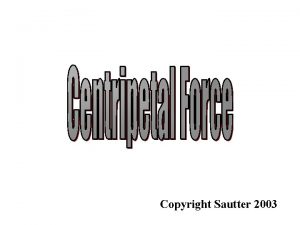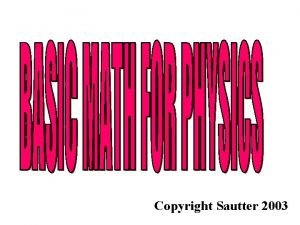W Sautter 2007 These are also called Compressional





























- Slides: 29

W. Sautter 2007

These are also called Compressional Waves

Crest Trough Compression Trough Rarefaction Compression = high Pressure Rarefaction = low Pressure

Frequency Wavelength Velocity Wavelength Frequency Velocity = x v

Wave B Wave A Constructive interference Wave A Wave B Destructive interference Wave B Wave A Partially Constructive interference

Intensity = Power / Area Sound Source Sound radiates out from a source as concentric spheres and follows an Inverse Square function

Inverse Square means as distance from the source doubles, the intensity 1/4 the original. If distance triples, the intensity is 1/9 the original and so on. The surface area of a sphere is given by 4 r 2 Power is measured in watts ( 1 joule / second) Intensity = Power / Area = watts/ 4 r 2 Or Watts / meter 2

d. B = 10 log ( I / I 0 ) I = the intensity of the sound to be evaluated I 0 = intensity of lowest sound that can be heard (1 x 10 -12 watts / meter 2)

Decibels are logarithmic functions • SINCE LOGS ARE POWERS OF 10 THEY ARE USED JUST LIKE THE POWERS OF 10 ASSOCIATED WITH SCIENTIFIC NUMBERS. • WHEN LOG VALUES ARE ADDED, THE NUMBERS THEY REPRESENT ARE MULTIPLIED. • WHEN LOG VALUES ARE SUBTRACTED, THE NUMBERS THEY REPRESENT ARE DIVIDED • WHEN LOGS ARE MULTIPLIED, THE NUMBERS THEY REPRESENT ARE RAISED TO POWERS • WHEN LOGS ARE DIVIDED, THE ROOTS OF NUMBERS THEY REPRESENT ARE TAKEN.

Decibels are logarithmic functions • A LOGARITHM (LOG) IS A POWER OF 10. IF A NUMBER IS WRITTEN AS 10 X THEN ITS LOG IS X. • FOR EXAMPLE 100 COULD BE WRITTEN AS 102 THEREFORE THE LOG OF 100 IS 2. • IN PHYSICS CALCULATIONS OFTEN SMALL NUMBERS ARE USED LIKE. 0001 OR 10 -4. THE LOG OF. 0001 IS THEREFORE – 4. • FOR NUMBERS THAT ARE NOT NICE EVEN POWERS OF 10 A CALCULATOR IS USED TO FIND THE LOG VALUE. FOR EXAMPLE THE LOG OF. 00345 IS – 2. 46 AS DETERMINED BY THE CALCULATOR.

Whisper 20 decibels Plane 120 decibels Conversation 60 decibels Siren 100 decibels

The frequency of a string depends on the Tension (N) and string Linear Density in kilograms per meter (Kg/m). Light strings under high tension yield high frequencies. Heavy strings under low tension yield low frequencies.

V (air) = 341 m/s at 20 o. C If observer is moving towards the source, V(observer) = + If observer is moving towards the source, V (observer) = If source is moving towards the observer, V (source) = +

at r e t Fas Slo we ra t lo wt em h p m e t igh p

0 C

Moving Toward observer Observed Frequency Is higher Moving Toward source

Moving Away from observer Observed Frequency Is lower Moving Away from source

Moving Away from observer Observed Frequency Is lower Observer At rest

Moving Toward observer Observed Frequency Is higher Observer At rest

3/2 1 Fundamental = 2 L Second Harmonic = L Third Harmonic = 2/3 L

fundamental d = diameter of tube L = length of tube at first resonant point If d is small compared to L (which is often true) then: fundamental

Since V= f If velocity is constant then as decreases, f increases In the same ratio Fundamental = 2 L Fundamental f = ffund Second Harmonic = L Second Harmonic f = 2 ffund Third Harmonic = 2/3 L Third Harmonic =3 ffund

1/4 Fundamental = 4 L 3/4 5/4 Second Harmonic = 4/3 L Third Harmonic = 4/5 L

fundamental d = diameter of tube L = length of tube at first resonant point If d is small compared to L (which is often true) then: fundamental

Since V= f If velocity is constant then as decreases, f increases In the same ratio Fundamental = 4 L Fundamental f = ffund Second Harmonic = 4/3 L Second Harmonic f = 3 ffund Third Harmonic = 4/5 L Third Harmonic = 5 ffund

Node Fundamental = 2 L Second Harmonic = L Third Harmonic = 2/3 L Node Fourth Harmonic = ½ L VIBRATIONAL MODES

Since V= f If velocity is constant then as decreases, f increases In the same ratio Fundamental = 2 L Fundamental f = ffund Second Harmonic = L Second Harmonic f = 2 ffund Third Harmonic = 2/3 L Third Harmonic = 3 ffund

Destructive interference Waves from a Distant source = crest = trough Constructive interference Barrier with Two slits In phase waves Emerge from slits

 Mikael ferm
Mikael ferm Non locomotor axial movements
Non locomotor axial movements Whats a compressional wave
Whats a compressional wave Parts of a compressional wave
Parts of a compressional wave Isoclinal fold
Isoclinal fold Compressional wave parts
Compressional wave parts Compressional mountains
Compressional mountains Dome vs basin
Dome vs basin Which of the following parsers is the most powerful ?
Which of the following parsers is the most powerful ? Bus stop method
Bus stop method Adjectives are also called
Adjectives are also called Minimum rent in royalty
Minimum rent in royalty A workbook is also called a
A workbook is also called a Brief work of fiction
Brief work of fiction The binding material in the mortar is also called
The binding material in the mortar is also called Circle graph is also called
Circle graph is also called A tree is a connected graph without any
A tree is a connected graph without any Citric acid cycle definition
Citric acid cycle definition Minto situation complication
Minto situation complication Physiological density ap human geography
Physiological density ap human geography What is graphics and media software
What is graphics and media software Complex carbohydrates are also called
Complex carbohydrates are also called Input and output of krebs cycle
Input and output of krebs cycle Byte stuffing
Byte stuffing What is this image called
What is this image called Womb is also called
Womb is also called A network adapter also called a ____
A network adapter also called a ____ Womb is also called
Womb is also called Glasses also called eyeglasses (formal)
Glasses also called eyeglasses (formal) Why are they called modal verbs
Why are they called modal verbs


